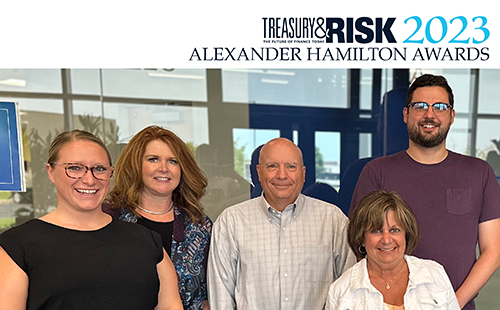 The idea of "sustainability" has taken hold in many areas of our businesses, and our lives, over the past couple of decades. Just as sustainable investments are those believed to cause no long-term social or environmental harm, sustainable supply chain management looks to incorporate environmental stewardship, wise resource utilization, and social responsibility into every rung of a corporate supply chain, from product design and material selection to distribution, consumption, and disposal of the final product.
The idea of "sustainability" has taken hold in many areas of our businesses, and our lives, over the past couple of decades. Just as sustainable investments are those believed to cause no long-term social or environmental harm, sustainable supply chain management looks to incorporate environmental stewardship, wise resource utilization, and social responsibility into every rung of a corporate supply chain, from product design and material selection to distribution, consumption, and disposal of the final product.
It is widely accepted that such an approach to supply chain management can generate significant value for businesses. The consulting firm Booz Allen Hamilton calculated that in organizations where supply chain management is part of the overall business strategy, annual savings improvements in manufacturing are nearly double those in businesses without such a strategy. Transparency evangelist Label Insight found in a recent study that as many as 94 percent of consumers would be loyal to a brand that offers complete transparency into its product.
Even so, a report released last year by Ernst & Young suggests that "many companies still do not have a comprehensive understanding of the performance, risks, and sustainability impacts of their supply chain."
Recommended For You
What Is Supply Chain Sustainability?
According to the U.N. Global Compact, supply chain sustainability is the "management of environmental, social, and economic impacts, and the encouragement of good governance practices throughout the lifecycles of goods and services." The supply chain for any given product varies, but in general consists of suppliers, manufacturers, and distributors. Within each of these categories can be one or hundreds of individuals or companies. Each single point is a potential risk, whether through human rights abuses, environmental negligence, or non-compliance with local, regional, national, or global standards.
Building long-term sustainability in a corporate supply chain involves taking into account an incredibly long and complex set of standards and issues. The social responsibility side of the sustainability equation is often the most difficult to manage. In the areas of the world where sustainability problems are most likely to fester, workforce protections may be sparse, enforcement may be minimal, and workers may be desperate for income even if it puts them at risk.
For those reasons, a well-thought-out supply chain sustainability program should include these four elements, at minimum:
1. Auditing Social Compliance
For companies looking to improve social responsibility up and down their supply chain, compliance audits are crucial.
Patagonia, the adventure apparel company, is an industry-leading example of how to ensure social responsibility throughout a corporate supply chain. For more than a decade, Patagonia has implemented a system, called the "4-fold" approach, to pre-screen potential partner factories. This four-step process includes screening new suppliers for the ability to meet sourcing, quality, social, and environmental standards. The company's supply chain team works closely with its sourcing and quality-control departments. All three functions have full veto power over whether Patagonia begins working with a particular factory. In 2011, the company began using the same process for suppliers of raw material fabric and trim.
 When conducting an audit on a supplier's factory, a company will likely expect the facility to register slight improvements in working conditions, hours, wages, etc. in every subsequent audit. However, even if audits meet this expectation, the reality may be that the factory has simply become better at preparing for the audits. Numbers that look good today don't necessarily reflect improvements that are sustainable in the long run. This tendency may render the audit process pointless, and may undermine suppliers' motivation to make the changes necessary to move into true compliance with the client company's social responsibility policy.
When conducting an audit on a supplier's factory, a company will likely expect the facility to register slight improvements in working conditions, hours, wages, etc. in every subsequent audit. However, even if audits meet this expectation, the reality may be that the factory has simply become better at preparing for the audits. Numbers that look good today don't necessarily reflect improvements that are sustainable in the long run. This tendency may render the audit process pointless, and may undermine suppliers' motivation to make the changes necessary to move into true compliance with the client company's social responsibility policy.
In combating such a scenario, a capacity-building approach can be crucial. The idea behind "capacity building" is that anytime there is a violation of supply chain sustainability policy, the company should take a continuous-improvement approach to identify what went wrong, how it went wrong, and what should be done to prevent this in the future. A company taking this type of approach to improving working conditions in a supplier's overseas factory would first launch an audit of the facility, carried out by fully trained auditors.
A good audit should employ a range of specialists—either employees of the company who are able to function independently, or employees of a contracted auditing firm—that are able to evaluate supplier performance against internationally recognized codes and standards. Throughout the audit process, they should be able to collect and evaluate quantifiable data that can serve as evidence to all stakeholders.
Then, to resolve any sustainability-policy violations that the audit uncovers, the client organization should work closely with the supplier to provide appropriate training to its employees and to develop long-term arrangements with management to improve the conditions at the factory.
2. Keeping Subcontractors on Track
Subcontracting is an issue that should be identified during a social audit. The various forms of subcontracting include:
- A factory supplier subcontracting the full order or part of the order to another factory;
- A factory supplier subcontracting one part of a process, such as dyeing, washing, or embroidery;
- On-site subcontracting, where intermediary labor is hired for a specific task by a middleman—for instance, a person might be contracted to complete a specific embroidery job, but might turn around and hire other people to complete that work for him/her;
- Commingling, in which multiple different supplier factories employ workers within one site; and
- Workers completing work on a product away from the factory, which is sometimes known as "homework."
All these scenarios increase the difficulty of ensuring that every worker in the supply chain is treated in a way consistent with corporate policy, but they do not remove the client company's social responsibility. Every link in a sustainable supply chain must exhibit social responsibility—and that includes all the subcontractors.
The upcoming ISO 45001 requires that an organization look beyond its own walls. Companies are responsible for the health and safety of all individuals who perform work for them, not only those whom they directly employ. In this way, the International Organization for Standardization hopes to ensure a higher level of health and safety among a wider group of affected workers. This means that the activities of external organizations that are influenced by, and exert influence on, an organization's health and safety objectives—including contractors and outsourcing firms—are included within the scope of the standard.
Hidden subcontractors can present operational and reputational risks, especially when work occurs outside of accepted regulations. It's hard to discuss risk management in supply chains without bringing up the deadliest garment-factory accident in history: the collapse of the Rana Plaza building in 2013, which killed more than 1,100 people. JCPenney and Benetton were among the large retailers surprised to find they carried apparel sewn there.
 When companies uncover hidden subcontractors, they have a responsibility to ensure that those organizations are compliant with their sustainability policies. They should address urgent problems with haste, and may need to halt production or offload work to another site. In an after-action review, companies should commit to aligning their purchasing practices to human rights standards, consider eliminating intermediaries, and perform appropriate human rights due diligence. In every case, capturing and evaluating data is crucially important.
When companies uncover hidden subcontractors, they have a responsibility to ensure that those organizations are compliant with their sustainability policies. They should address urgent problems with haste, and may need to halt production or offload work to another site. In an after-action review, companies should commit to aligning their purchasing practices to human rights standards, consider eliminating intermediaries, and perform appropriate human rights due diligence. In every case, capturing and evaluating data is crucially important.
But how can a company halfway around the world identify where subcontractors are working for its suppliers and then evaluate those subcontractors' sustainability practices (or lack thereof)? Broadly, having communication and transparency at every level is key.
First, the social responsibility auditor needs to engage in a dialogue with the supplier, as Patagonia does. Red flags should be raised if, for example, the number of workers in a given factory does not appear to be consistent with the production output. To do this effectively, the auditor must be educated on the purchase practices of the client organization, and on the risks that are common in the country in question. It also makes sense to use an auditor who understands the local language and culture. A language barrier can limit the effectiveness of worker interviews, if those are required to uncover issues.
Another method for uncovering noncompliant contractors or subcontractors is to engage in a dialogue with peers in your industry. It is common for many businesses, even competitors, to work with the same factory supplier. Those that openly discuss supply chain sustainability issues may find a pathway to collaboration on identifying situations such as hidden subcontractors. Only through ongoing dialogue will a business successfully identify and resolve these issues.
3. Ensuring All Workers Earn a Living Wage
A key element of a socially responsible supply chain is that everyone earns a living wage. There's nearly universal consensus on this point—but there is also an ongoing debate regarding what constitutes a living wage. This is because oftentimes the minimum wage in a jurisdiction doesn't equate to what many would consider a basic "living wage."
To the Global Living Wage Coalition, a living wage enables a worker "to cover the essential needs of their family, with a little extra 'just in case.'" More formally, the group defines the term "living wage" as:
The remuneration received for a standard work week by a worker in a particular place sufficient to afford a decent standard of living for the worker and her or his family. Elements of a decent standard of living include food, water, housing, education, health care, transport, clothing, and other essential needs, including provision for unexpected events.
The Global Living Wage Coalition embodies an ongoing initiative to identify and publish the specific living wage for each market around the world. It's a good idea to set your own company's benchmarks by using this or another similar standard for your particular region, or to do so in conjunction with third-party auditors. This will help ensure that workers at the supplier factory are being adequately compensated, a crucial piece of the sustainable supply chain.
We anticipate that increasing numbers of companies will focus energy on ensuring that everyone in their supply chain earns a living wage as the first round of this project is completed in the coming years.
4. Avoiding Conflicts in Conflict Industries
"Conflict" minerals and other natural resources are extracted in a war zone and sold to perpetuate the fighting. The Dodd-Frank Act included a provision requiring companies to disclose whether their supplies of four minerals—tin, tantalum, tungsten, and gold—were sourced in conflict zones. Although the SEC suspended enforcement of this rule in April, transparency on the sourcing of conflict minerals is one more crucial component of a socially responsible supply chain.
In addition to the four minerals listed in Dodd-Frank, diamonds are at risk of coming from war zones and funding violence. Even oil, when extracted in a volatile region of the world, can be considered a "conflict" substance.
The best way to find out whether resources come from conflict zones is, again, through strong data collection. For example, the Responsible Minerals Initiative has a downloadable template that can help companies determine which of their raw materials are risky. The OECD also offers a guidance document designed to help businesses develop and follow due diligence practices to ensure they are not contributing to human rights abuses.
Maintaining Sustainability
While these four elements are the tip of the iceberg in creating a socially responsible supply chain, they are important foundational considerations that companies in any industry can build upon. Then, when a first-world corporate entity sees a gap in which businesses, or entire industries, are operating in a socially irresponsible manner, it may be able to address these ethical failures by alerting enforcement agencies to the problem.
In the absence of either regulations or the will to enforce them, we encourage taking a multi-stakeholder approach that enlists individuals, companies, and regulatory bodies to ensure that problems are addressed. While it can be a lengthy process, it is generally agreed to be the best way forward, as it ensures that the sustainable practices have scale, impact, and efficiency. By working together alongside non-governmental organizations (NGOs), larger businesses, etc., smaller companies and individuals can gain leverage to create change.
As shoppers find it increasingly difficult to turn a blind eye to the origins of what they're scanning in the checkout line, businesses will have to answer to an increasing consciousness. It's only a matter of time before consumers have technology that enables them to peer digitally into any part of the supply chain to discover information about each process. For companies, it's worth taking action now to make their supply chain as clean as possible, before the inevitable time comes when transparency is the norm.
————————————
 Mark Ward is general manager at UL EHS Sustainability, leading an international team of 300 employees who empower organizations to protect the well-being of workers, reduce risk, improve productivity, enhance compliance, and drive measurable business improvement.
Mark Ward is general manager at UL EHS Sustainability, leading an international team of 300 employees who empower organizations to protect the well-being of workers, reduce risk, improve productivity, enhance compliance, and drive measurable business improvement.
© 2025 ALM Global, LLC, All Rights Reserved. Request academic re-use from www.copyright.com. All other uses, submit a request to [email protected]. For more information visit Asset & Logo Licensing.




